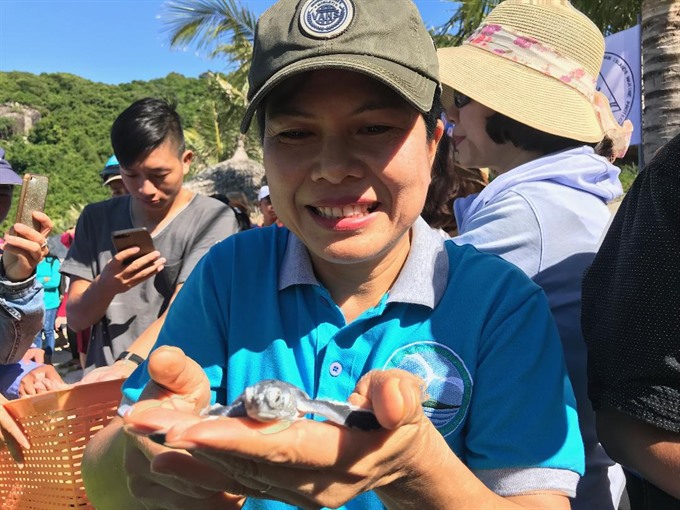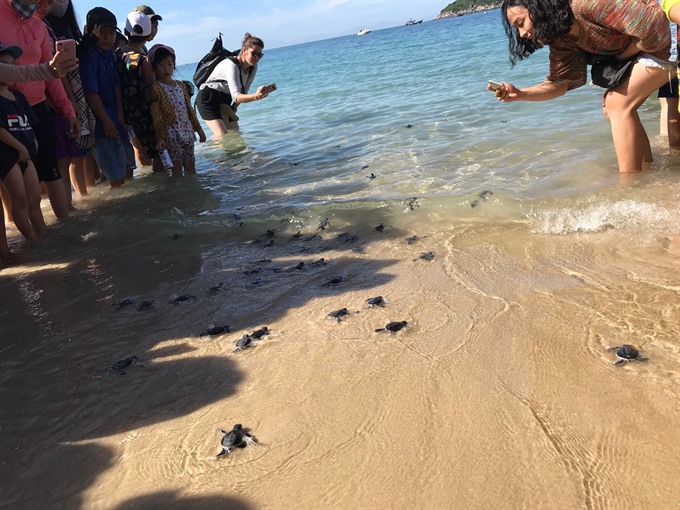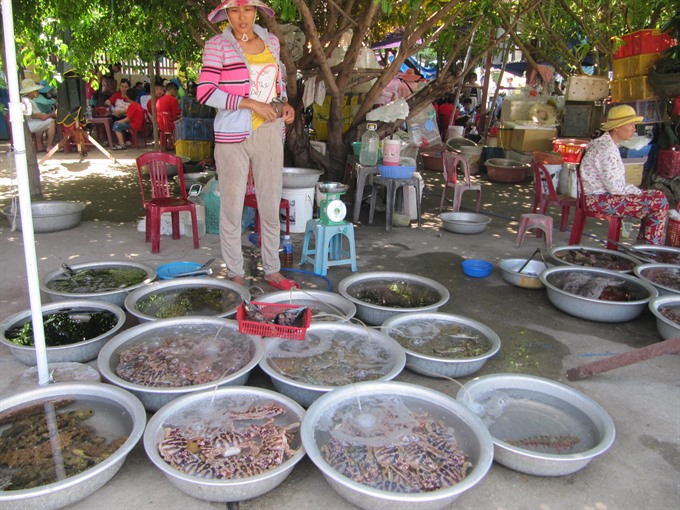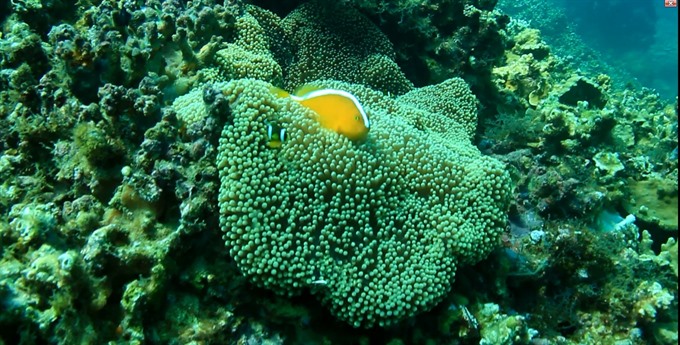 Sunday/Weekend
Sunday/Weekend

A project aimed at saving rare sea turtles on Chàm Island has achieved the added bonus of teaching residents the importance of caring for the environment and in turn boosted tourism. Bùi Hoài Nam reports.
 |
| A staff of the Chàm Island Marine Protected Area set a baby turtle to the ocean. — VNS Photo Phạm Hải |
A project aimed at saving rare sea turtles on Chàm Island has achieved the added bonus of teaching residents the importance of caring for the environment and in turn boosted tourism. Bùi Hoài Nam reports.
A team of researchers from the Chàm Island’s Marine Protected Area (MPA) have relocated 900 turtle eggs and released 800 baby turtles into the ocean as part of a conservation project over the past year.
The eggs, taken from turtle nests on Côn Đảo Island in Bà Rịa-Vũng Tàu Province, were transported more than 1,000km before being placed in new nests on a beach on Chàm Island in the south central province of Quang Nam.
Researcher Lê Xuân Ái said the conservation project had given hope for the repopulation of turtle species in areas where they were on the decline.
“Beaches in central Việt Nam are seen as safe places for sea turtles to lay their eggs, but rapid development has damaged their environment,” Ái said.
“Naturally, baby turtles often return to the beach where they were born to lay their own eggs when they reach maturity about 30 years later. The baby turtles we released from Chàm Island will likely return to spawn the next generation,” he explained.
 |
| Tourists and Islanders enjoy releasing baby turtles to the sea. — VNS Photo Phạm Hải |
He said the project would build up a base creating safe nests for turtle reproduction and conservation to restore the endangered species.
Trần Thị Hồng Thúy, director of the MPA, said an area of 40sq.km on Bãi Bấc Beach had been designated as a protected site for turtles to nest.
“We plan to expand a strict protection area for the green turtle (Chelonia mydas) species,” Thúy said.
“A quiet, safe, clean and ‘green’ aquatic environment and pristine beaches will be reserved for turtle conservation only.”
Ái said the green turtle was very sensitive to human activities and pollution, and they would leave the beaches if they felt unsafe from enemies (dogs, snakes or birds).
“Turtles often produce eggs when they reach 30-35 years old. We have witnessed turtles arriving on the beach to lay their eggs, but then leaving due to various threats,” said Ái, who has 30 years experience in turtle conservation.
Nguyễn Thị Huyền Trang, who voluntary joined a turtle conservation project with the International Union for Conservation of Natural Resources (IUCN), said that turtles often laid at least 80 eggs each between April and September.
“We had to clean the beach for the turtles to lay their eggs at night. They leave if they find rubbish on beach,” Trang recalled.
“The number of male or female baby turtles depends on the temperature and sun. Young turtles go out to sea 45-60 days after hatching.”
 |
| Pristine beaches of Chàm Island. — VNS Photo Công Thành |
Environment improved
Nguyễn Tám, 53, a fisherman on the island, said that it had been polluted by rubbish and untreated seafood from fishing boats.
“The ocean was a huge dustbin for islanders. The beach was piled up with garbage from fishing boats and households,” he said.
“The coral reefs are damaged by anchors of the fishing boats. During stormy weather, we have no clean water or power, and the island is isolated from the mainland,” he said.
Tám said the island was one of the poorest communes in Hội An ancient town 20 years ago, and islanders were forced to rely on food supplied by the town.
However, things have changed.
Since Chàm Island was recognised as a World Biosphere Reserve site by UNESCO in 2009, communication campaigns on the importance of its rich biodiversity and the need to protect the marine and forest ecosystem by the MPA and international conservation organisations.
Islanders have been educated about the environment and marine habitat protection through training courses.
“We have gradually come to understand the value of nature. Most islanders now know the importance of keeping the island clean because it will improve their lives. More tourists are arriving and fish stocks are on the rise, while the coral reefs are better protected,” he shared.
Tám said his family now offered homestay services and a shop for tourists.
“No more littering, and no more plastic bags are used by islanders and visitors. Tourists are told not to use plastic bags at Cửa Đại Port before they head to the island,” chairman of Tân Hiệp Island Commune Nguyễn Văn An said.
“Dustbins are available around the island, and a solid waste treatment plant has been built to incinerate rubbish,” An said
“A tourism boom in recent years has helped improve the people’s earnings from home-stays, restaurants, motorbike rental and tours. Islanders enjoy a better income from tourism rather than traditional trades like fishing and crafts,” he added.
 |
| The gate of an old pagoda on Chàm Island. — VNS Photo Công Thành |
 |
| The seafood market of Chàm Island. — VNS Photo Công Thành |
 |
| Colourful coral reefs in water off the Chàm Island. — VNS Photo Công Thành |
Hạnh Phương, the owner of a seafood restaurant, said islanders now used paper bags or re-useable baskets instead of plastic bags.
“It’s taken time to educate the people. The island has turned ‘green’ since the campaign to say no to littering and plastic bags started,” said Chu Mạnh Trinh from the MPA.
“Fishermen now acknowledge a ‘no fishing’ area in the MPA core-zone, and they carefully release small fish, crabs and turtles from their nets,” he said.
“The successful story of turtle conservation on the Chàm Islands is a magnificent example of education on environmental protection. The ex-situ conservation practice had been succeeded in other countries in the world, but it’s the first time in Việt Nam,” said Bùi Thị Thu Hiền, an expert from the IUCN.
“It needs to continue in the near future with positive support from the local administration and community for prolonged mass conservation.”
The 2,400 inhabitants of the island, which also includes eight islets with vast ecological diversity, earned US$3.6 million last year, 65 per cent of which was from tourism and service.
More than 70 per cent of the population has turned from fishing to eco-tourism, which has doubled their income since the area was recognised as a World Biosphere Reserve.
“Keeping the island a ‘green’ and ‘clean’ site through simple actions within the community will help develop it into unique world attraction of culture and biodiversity,” said conservationist Ái.— VNS